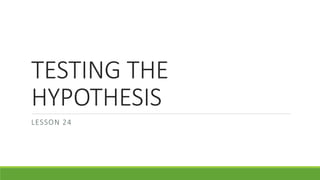
Lesson 24 testing the hypothesis
- 2. INTRODUCTION Hypothesis testing is an important part of the data analysis plan in conducting a research study. If the researcher wishes to draw some inferences from data taken from a sample which may have wider generalizability.
- 3. STATISTICAL SIGNIFICANCE It means that a relationship between two or more variables is caused by something other than by random chance. Significant also means probably true (not due to chance). When the result is highly , it means that is very probably true.
- 4. HYPOTHESIS A hypothesis is a preconceived idea, assumed to be true and has to be tested for its truth or falsity.
- 5. TWO TYPES OF HYPOTHESIS 1. Null Hypothesis- a statement of neutrality. Example: There is no significant relationship between gadget usage and academic performance. 2. Alternative Hypothesis – a statement of non-neutrality. Example: There is a significant relationship between gadget usage and academic performance.
- 6. Type I and Type II Errors 1. Type I Error is committed when a researcher rejected a null hypothesis when in fact it is true. 2. Type II Error is committed when the researcher fails to reject the null hypothesis when in fact is false and should be rejected.
- 7. PARAMETRIC AND NON-PARAMETRIC STATISTICS Parametric Test are used for interval and ratio scales of measurement. They require that the samples and observations are drawn from normally distributed populations and that the selection of each case should be independent of the other. The population should have equal variances.
- 8. PARAMETRIC AND NON-PARAMETRIC STATISTICS Non-Parametric Test do not specify normally distributed populations and similarity of variances. Nonparametric tests are the only tests used with nominal data or ordinal data.
- 9. Steps in Hypothesis Testing 1. State the null hypothesis. The null hypothesis is a statement that no difference exists between the averages or means of two groups. Example: Let us suppose that an advertising agency is conducting an experiment using two different methods of marketing strategies (X and Y) to grade 11 students. The result of the experiment will be measured using the monthly sales of the company. Hypotheses: A. Strategy X is equal to strategy that is (X=Y) B. Strategy X is better than strategy Y, that is (X>Y) C. Strategy X is poorer than strategy Y, that is (X<Y)
- 10. Steps in Hypothesis Testing 2. Choose the statistical test and perform the calculation. A researcher must determine the measurement scale, the type of variable, the type of data gathered and the number of groups or the number of categories. 3. State the level of significance for the statistical test. The level of significance is determined before the test is performed. It has been traditionally accepted various school of thought to use alpha (the level of significance) 𝛼 = 0.05, 0.1 𝑎𝑛𝑑 0.001
- 11. Steps in Hypothesis Testing 4. Compute the calculated value. Use the appropriate formula for the significance test to obtain the calculated value. 5. Determine the critical value the test statistics must attain to be significant. After you have computed the calculated measure, you must at the critical value in the appropriate table for the distribution. The critical value defines the rejection from the region of acceptance of the null hypothesis. The areas of acceptance and rejection in a standard normal distribution, using 𝛼 = 0.05.
- 13. Steps in Hypothesis Testing 6. Make the decision. If the calculated value is greater than the critical value, you reject the null hypothesis. If the critical value is larger, you conclude you that you failed to reject the null hypothesis.